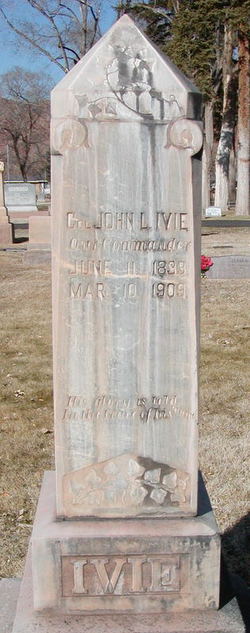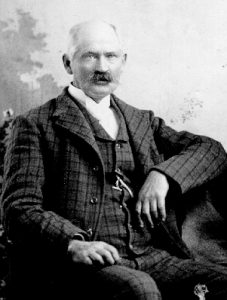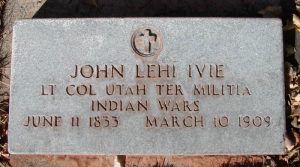
 John Lehi IVIE
John Lehi IVIE
Allred Lineage: John Lehi, James Russell, Sarah, William, Thomas, Solomon born 1680 England
Born: 06/11/1833
Died: 03/10/1909
Submitted by: Sharon Allred Jessop 12/02/1998
Stories of Col. John Levi Ivie
Taken from “Indians Depredation in Utah” By Peter Gottfredson
Compiled by Georgia E. Ivie
Col. John Levi Ivie of Mt. Pleasant, Utah was the son of James Russell Ivie. He fought in seven battles with Indians and lead three of them. Under General Warren S. Snow who took command of the Sanpete Militia July 15. With a hundred men under him he was after the Indians responsible for a double murder of two men. They wanted to head off the hostile Indians in the mountains of Fish Lake. They founds many Indians hiding in the cedars. Col. Ivie’s company were on outskirts of the Grove and did not see many Indians that after the fight some of his men wanted to go back and look for dead Indians and guns but the Col. said, “No, let the squaws go and hunt up their papooses.” The Ivie’s company drew off.

Old father James Russell Ivie and Henry Wright were killed in Scipio. On the morning of June 10, 1866 a large band of Indians under Chief Black Hawk made a raid on the stock in Round Valley, Millard, Utah. They killed father James R. Ivie, father of John Levi Ivie, James A. Ivie, and others, and mortally wounded Henry Wright, a young boy who was out looking for stock. They drove off about 500 head of cattle and horses. As it’s known that they would come towards Salina, a messenger was dispatched to fort Gunnison, where it was known that General William B. Pace, with a company of thirty men were stationed. But when word of the trouble a Scipio reached the camp, General Pace and others were on their way to Manti. A message was dispatched a post haste and up with the party at 12 Mile Creek, just below the present site of Mayfield. The company returned to Gunnison through a heavy thunder storm.
Salina, which had been vacated in April, was reached by daylight and here it was decided to take a few hours rest. Accordingly, the picket were sent out and the men began to prepare for a rest, but had not proceeded very far when one of the guards discharged his gun, which was the signal agreed upon that the enemy had been sighted.
Black Hawk was wounded at Gravely Ford when the Indians was driving a bunch of cattle. He was riding a horse stolen from the Ivie’s. Black Hawk, the Indian Chief, was figured so prominately in the Utah Indian War of 1865-67. In 1870 Chief Black Hawk died at Spring Lake Villa, a small settlement situated between Payson and Santaquin, Utah Co., Utah.
A letter from William Robert dated at Provo, Utah, July 1, 1915.
Mr. Peter Goltfredson, Springville, Utah
Dear Sirs:
I am very glad to comply with your request to give some items of history of some of the Indian troubles in and near Round Valley (Scipio) and on the following narrative. I am sure some of the erroneous stories told in regard to the death of Black Hawk, the Great Indian Chief, and also Panaccara, an offensive Indian who made his home in Round Valley, may be corrected and the truths of the matter given to the people in your proposed history of the Indians trouble of the early Utah days.
There are probably a dozen men in Utah who claim the honor of killing Black Hawk. None of which is true. It is true the Black Hawk was severely wounded in the fight at Gravely Ford on the Sevier River, near what is now called Vermillin, but he lived three of four years after receiving the wounds, and before his death, Black Hawk obtained permission from the military authorities of the Territory to visit all the places where he and his tribes had caused trouble or raids, and accompanied by a few 7 to 8 warriors. Black Hawk visited every town and village from Cedar City on the south to Payson on the North and made peace with the people. On this mission of peace he was provided with an escort, usually from 2 to 6 citizens, from town to town. Ausel P. Harmon and myself acted as such escort from Holden to Scipio, Millard Co. Black Hawk told the people wherein he went that he was going home to die and before the end came he desired to be at peace with the pale faces.
Black Hawk died at his wigwam near Spring Lake in 1869 or 1870, the exact date I am not able to give. He was buried in the foot hills immediately east and south of Spring Lake Villa, Utah Co.
Because of the killing of old man Ivie (James Russell Ivie) in Round Valley, a few years before by members of Black Hawk’s tribe, it was feared that the old warriors would be harshly treated by the Ivie family on the trip through the Valley, unless provisions were made in advance for his protection from assault from that source.
The Ivie’s had previously sworn vengeance, and some time before Black Hawks appearance on his mission of peace, the old Indian Panaccara, had been shot to death by James A. Ivie. In order to justify himself Ivie charged that Panaccara was a spy for the Ute Indians on the south, which was not true, as Panaccara was a special fried of the white people in that vicinity and was hated by the Utes.
On one occasion a band of Utes came to the Valley for the sole purpose of the killing him.
Panaccara was for number of years before his death “medicine man” for the Pahvant tribe, whose home was in Millard Co. and this tribe of Indians was always friendly with the white settlers. Panaccara’s death at the hands of Ivie was brought about in this way: The old Indian came to the town of Scipio, and as was customary he carried a gun. This custom was objected to by the military authorities a rule was adopted that Indians should not carry arms when visiting the settlement. Accordingly, the acting justice of the peace Benjamin Johnson prevailed upon the old Indian to give up hit gun. The Indian willingly gave the gun to the justice and started out to cross the hill in the direction of Oak Creek, where Ivie followed him, and on the flat, about two miles from town. He overtook the Indian and without warning, shot him dead. He was buried where he was killed. According to the Indian custom, it was a “life for a life” and it did not matter to them who it was just so they got their revenge by killing a white. For the death of Panaccara I came nearly losing my scalp at the hands of Nun-ka-tots ( a particular friend of Panaccara ) who lived most of the time with him. I was on my way from Deseret to Scipio with a load of wheat and on reaching a point on the desert near Mud Lake the reflection of a gun showed an Indian in hiding behind a mount near the road. I jumped off the wagon ready with my rifle for action when the Indian rode away. For seven years this Indian avoided me and finally came to me and asked if I was “To Buch now.” I told him I was to “Tobuch” and he said, “Me no tobach now”, and from then on this Indian and I were friends.
Signed William Robert
Manti, Utah, Feb. 12, 1914
This article was taken form the Book “Indian Depredation in Utah” By Peter Gottfredson.
RAID ON SCIPIO
Fifteen head of Horses stolen of other Indians raids which took place in 1868. We may mention that on May 7, four Indians made a raid on Scipio, Millard Co. And drove off fifteen head. On July 5th, Seth Childs was accidentally shot and wounded near Gunnison, Sanpeteco. By an Indian who proved to be friendly.
Indians stop Col. Ivie in Salt Creek Canyon.
(Copied from the Desert News, July 10th, 1947)
We met Bro. Henry N. Tarter of Moroni, Sanpete Co. Today who arrived in town yesterday in company with Col. John S. Ivie and latter family. He reports that when they were about four miles below the divide above Salt Creek Canyon, six Utes among whom was Labiona, rode up to them and demanded to know of Col. Ivie whether he was “Jim Ivie” the Colonel’s brother. On being answered in the negative they passed on.
In short time, they returned, rode in front of the wagon and stopped it, reiterated the question. One of the Indians then said that it was not “Jim Ivie” but his brother. At this time, Tabiona had his hand on his arrow and the other had his rifle ready to use. The Indians passed along and after going a short distance they stopped and held a council. The team was made to travel at a lively pace. When the Indians saw this two of them started after it, coming toward the wagon about 300 yards, but seeing their companions did not follow they stopped and went back. One Indian was so drunk he could scarcely set on his house, and the others had been drinking, but they knew what they were doing.
James Oscar Ivie, son of Col. Ivie, one of the children in the wagon said Lyman R. Peters was the driver. Mrs. Ivie and the children were very much frightened; the mother covered the smaller children with the bedding in the wagon. Col. Ivie said afterward that if the Indians had overtaken them the second time, he intended to jump out of the wagon and let it go on and take his chances with them, He was well armed.
INDIAN GRATITUDE
The following is an incident as related by Col. John L. Ivie, to his son James Oscar Ivie.
During the Indian troubles in the 60's the Indians had stolen some cattle and drove them up North Creek Canyon, between Fairview and Mount Pleasant. Father John L. Ivie and his company of minute men were in pursuit, and going up the mountain they gathered up several head of cattle which had been left along the trail, on account of not keeping up with the herd, and up among the timber was discovered a love Indian covered with leaves, he was sick, and not able to travel with the rest. Some of the boys wanted to kill him, but father said, “No, we will not shed blood unless it is necessary.” So they left him and went in pursuit of the Indians and the stock until nearly night, when it was decided to give up the chase and return him, taking back what stock they had.
On their return they came across the sick Indian up against a tree smoking a pipe. The men still wanted to kill him, but father wouldn’t let them.
Some time after that father and two other men were standing guard over some stock in the North Fort of Mt. Pleasant, they would frequently meet and report to each other during the night. They had got together at the north side of the fort, when they saw and heard the cattle getting up from their bed ground and moving away from what they thought might be a Indian crawling among them. The cattle kept getting nearer and nearer to where the men stood. When father spoke up to the other and said that they must be close by. After that the cattle started moving as if some thing among them was going away from them. When morning came nothing had been molested.
In the beginning of the 70's, after peace had been restored, an old Indian and his family came to our house and spent a day or two. He told father of the accurance at the fort explaining that he and five Indians were there that occasion and had their guns lying across a cow ready to shoot the three men, when they heard father speak and say, “They must be close by.” He knew father’s voice and would not let the other shoot at father. Father had saved his life on the mountain when he was sick. In appreciation he had now saved father’s life.
By James Oscar Ivie
Col. John Lehi Ivie
Col. John Ivie of Mt. Pleasant sent the following dispatch:
Gov. George L. Woods Mt. Pleasant Aug. 17, 1872
Care of Daniel H. Wells
Indian depredation here last night. Shall I call out the militia to defend the place of services generally in the county? The Indians attacked the telegraph operator about 11 o’clock last night in front of the office and we fear, fatally wounded him.
Col. John L. Ivie
Col. of Militia
